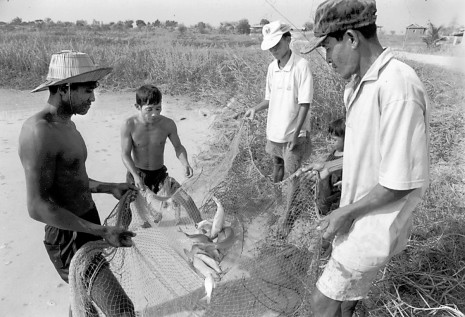Tuol Krasaing village, Kandal province – Long Sien, a lifelong rice farmer, told a group of his counterparts recently how aquaculture can help their agriculture.

For the past three years, the 50-year-old farmer has supplemented his diet and his income by raising fish, helped by the Scale Integrated Agriculture Program.
“At first I didn’t think this was a good project for me, but after a year I finally got good results,” he told a group of about 400 fellow rice farmers last month.
The program is part of the British-based NGO Southeast Asian Outreach’s efforts to help Kandal farmers to raise fish, according to Herman Brouwer, human resources adviser to the project.
Brouwer says Long Sien is one of the program’s success stories. The farmer admits, however, he went through many trials and tribulations before he finally turned a profit.
“In the first year, all the fish died. The second year was good, but on the third year when floods came, all the fish swam out of the pond,” he said.
This year, however, he managed to supplement his income by $2,880 by selling surplus fish. He also sold $1,880 worth of fruits and vegetables grown around the pond.
Brouwer said the ponds are intended to be self-sufficient. The program lends money to farmers for fingerlings (juvenile fish), but after that only provides advice.
Farmers are taught how to find food for the fish on their farms, such as cow dung, termites and plants.
Scale, along with the Kandal Department of Agriculture, has established a development center in Tuol Krasaing village in Sa’ang district to support the project.
The 10-hectare site includes a hatchery capable of producing 4 million minnows per year, 38 ponds, an artificial spawning facility and a training center.
Some 325 households in Kandal province now have fish ponds, Brouwer said. So far, the program has focused on the drier districts away from large bodies of water. Eventually, the Cambodian government would like to have a hatchery in every province, he added.
The fingerlings take about six months to mature, he said. Most of the ponds are rain-fed so the fingerlings are put in the water during the rainy season.
The fish come to maturity during the dry season, so farmers can have a steady source of protein after they have finished growing rice.
Some of the larger ponds can last until April, he said.
Although cash can be made by selling surplus fish, Brouwer says, the project’s main goal is to help feed Cambodians.
“In the past, you didn’t need something like this because there were plenty of fish in the rivers and large bodies of water, but the amounts…are decreasing due to environmental damage,” he said.




